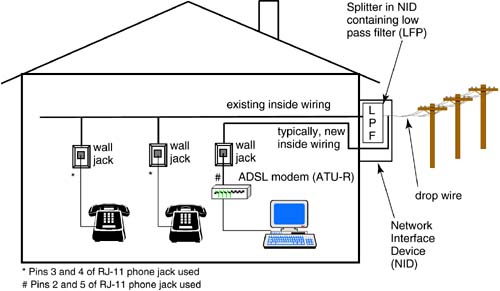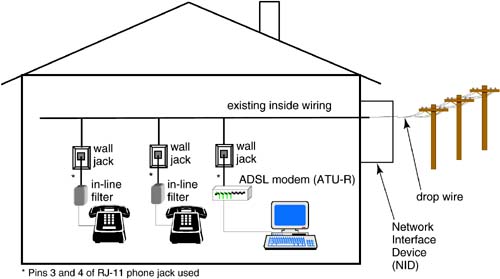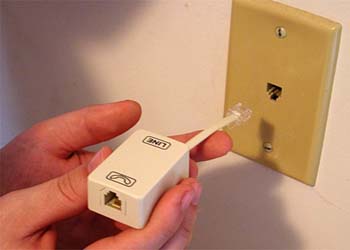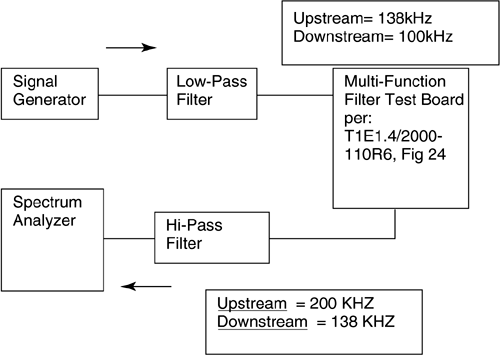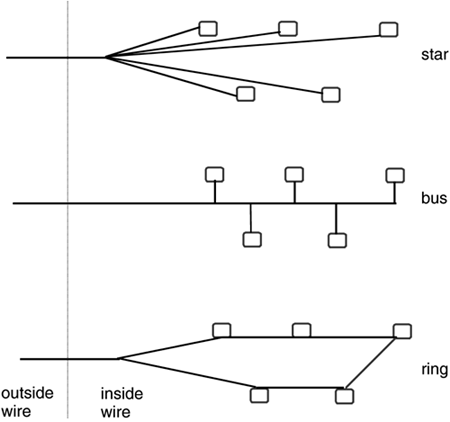12.2 Inside Telephone Wiring and ADSL
| As shown in Figure 12.1, the telephone distribution cable connects to the customer premises via a drop wire that typically consists of two to four pairs of wire. Starting in the year 2000, the industry widely adopted self-installation by customers using the splitterless customer premises configuration shown in Figure 12.2. The splitterless configuration uses the same pair of inside wires for POTS and ADSL data; this pair of wires is known as line-1 and connects to pins three and four of the telephone wall jacks . Despite being called "splitterless," this configuration typically includes a line-sharing splitter at the central office end of the line. Figure 12.1. Customer premises configuration with shared splitter. Figure 12.2. Splitterless customer premises configuration. The splitterless customer premises configuration was introduced with ITU Recommendation G.991.2 (g.lite), which contained a fast-retrain function to permit the ADSL modem to quickly adapt to changes in the transmission channel resulting from telephones on the same line going on-hook or off-hook. During the development of G.991.2, it was discovered that the fast-retrain was not adequate to assure good voice- band and data performance when some types of phones were directly connected to the same line used by the ADSL. Thus, it is necessary to place a low-pass in-line filter at the connecting cord to every phone and answering machine. Subsequently, it was also discovered that the provision of in-line isolating filters not only assured good performance for G.991.2, but also the full-rate G.991.1 (g.dmt) and T1.413 standard equipment. So, what was originally intended as a g.lite feature, has evolved to a general practice for splitterless configurations using G.991.1 and T1.413 full-rate equipment to facilitate potential future upgrade to service rates above 1.5 Mb/s. Prior to the year 2000, the predominant configuration for the customer premises required a splitter located at the point where the telephone wires entered the premises. For single family homes , the splitter is often placed within a wiring junction box called the network interface device (NID), located on the outside wall of the premises. As shown in Figure 12.1, the splitter consists of a low-pass filter (LPF) in series with the existing inside telephone wiring connected to the line 1 phones within the premises. A separate pair of inside wires connect the ADSL modem to the telephone line; often a new CAT-5 wire is installed. New wire is often installed because a spare pair of inside wires is not available. Even if a spare wire pair is available, the wire quality may be inadequate. The splitterless configuration is now practiced for approximately 90 percent of ADSL installations because it avoids the cost and inconvenience of a technician visiting the customer premises. The customer simply plugs the ADSL modem into any telephone wall jack, inserts a small in-line filter by every telephone and answering machine, and runs the setup program on their computer. The customer self-installation success rate is approximately 95 percent. A portion of the cases where self-installation fails is due to poor quality inside wiring that is susceptible to noise ingress and also presents many short bridged taps at the customer-end of the line. Thus, the shared-splitter configuration continues to be applied in a few cases to overcome the impairments presented by the existing inside wiring. The splitter at the NID isolates (at higher frequencies) most of the inside wiring from the newly installed CAT5 wire connecting to the ADSL modem. The configuration with the splitter at the NID is also preferred for customer installations having a reporting security alarm service. There have been reports of splitterless ADSL installation causing malfunction of alarm systems that automatically dial a voice-band modem call to the alarm service station. Further information on customer premises configurations is provided in DSL Forum TR-007. 12.2.1 In-line Filter (Microfilter)T1E1.4 developed U.S. standard T1.421-2001 for customer premises in-line filters (also known as microfilters) to isolate telephone instruments from DSL equipment sharing the same inside wire pair. The in-line filter consists of a low-pass filter (LPF) with a RJ11 jack connected to one side of the filter and a RJ11 plug connected to the other side (Figure 12.3). The in-line filter plugs into a wall jack, and the telephone connecting cord plugs into the RJ11 jack within the in-line filter. Typically, a separate in-line filter is used for each telephone, answering machine, voice-band modem, or other telephone-type equipment. However, an Y-adapter would allow more than one telephone instrument to share the same in-line filter. Every telephone instrument connected to the DSL line must be connected via an in-line filter. The in-line filters permit only voice-band signals to and from the telephone instruments. This solves two problems resulting from the telephones and the DSL sharing the same line: (1) noise audible in the telephones due to DSL signals being cross-modulated by the telephone, and (2) impaired DSL transmission due to noise from the telephone equipment and changes in line impedance when the telephone goes on-hook or off-hook. Figure 12.3. In-line filter and wall jack. Without a filter, approximately one-third of telephones will exhibit objectionable hissing in the ear piece when connected to an ADSL line. The impedance characteristics of telephone models vary widely, with many telephones presenting a high impedance during on-hook, and as low as 10 ohms at ADSL frequencies when off-hook. An ADSL transceiver that has adapted to the line characteristics is suddenly presented with radically different channel characteristics when a phone goes on- or off-hook, and thus is forced to cease transmission while it readapts to the new line characteristics. This is particularly troublesome if pulse-type dialing is used where the line repeatedly changes between on-hook and off-hook. Furthermore, a very large noise burst can occur when a telephone goes off-hook while the ringing signal is near its maximum voltage; this event is called a ring-trip . In-line filters were originally created for use with ITU G.992.2 (G.lite), but the in-line filters are useful for G.992.1 (G.dmt), T1.413, and certain proprietary DSLs. HomePNA usually does not require in-line filters, but the filters can help in cases where the telephone equipment causes excessive noise at high frequencies. Several 900 MHz and 2.4 GHz cordless phones emit noise that interfere with DSL. In some cases, power supplies or electric motors (for an answering machine tape drive) in the telephone equipment can generate high frequency noise. The simplest in-line filter design is non symmetrical , meaning that one side of the filter must face the telephone and the other must face the wall jack. Nonsymmetrical filters (also called polarized filters) are clearly marked "line" and "phone" to indicate the correct orientation. The in-line filters are designed to plug directly into the wall jack to isolate the connecting cord from the house wiring. This improves the high frequency characteristics of the premises wiring by effectively shortening the length of the wiring stub. Because telephone connecting cords have a plug at both ends, it is possible to connect the in-line filter at phone-end of the connecting cord. This would result in the polarized filter facing the wrong direction, and thus diminishing the quality of service. In the case of a phone cord already connected to a wall jack behind a bookcase , gaining the necessary access to the wall jack could be very inconvenient. As a result, some in-line filters are designed to be symmetrical , meaning that they work as well regardless of which side of the filter faces the phone. Symmetrical filters are an advantage for people with jacks behind large heavy objects such as bookcases. This design is also helpful for others because there is no way to connect the filter backward. In-line filters are also packaged within a shim-plate adapter that fits between a wall-phone and the standard wall plate. In-line filter design must simultaneously assure:
Detailed Discussion of T1.421 ”The In-Line Filter StandardAll these attributes must be maintained when connected to any type of telephone, and when several in-line filters are connected to the premises wiring. The T1.421-2001 in-line filter standard requires that the specifications be met when up to five in-line filters are connected in parallel. In practice, tolerable service will often be achieved when more than five in-line filters are connected. In-line filters are designed to let Caller ID signals pass through. The in-line filter characteristics are specified up to 10 MHz to help provide for future DSL technologies and local phone-line networking (e.g., HomePNA). One in-line filter design employs a third-order Chebychev II symmetrical design. T1.421 includes the terms, purpose, and the scope of the testing, on-hook testing, off-hook testing, and high-band frequency testing. The physical characteristics and packaging are also discussed. We concentrate on the portions of the standard where the filter testing takes place. The purpose of the standard is to present the electrical and physical characteristics of an in-line DSL filter. The filter is then used to protect the voice-band equipment from the high-frequencies generated by the digital data over voice in the 25 kHz “10 MHz range. Filters are also used to protect data over voice equipment from impedance changes and other impairments caused by the off-hook and on-hook transitions of voice-band equipment. The in-line DSL filter standards benefit users and service providers of voice/data services by simplifying interpretation of customer provided equipment (CPE) and by defining the parameters of a single filter up to a total of five filters. In installation of more than five filters, it is necessary to add dynamic filters that exhibit all of their filtering only when the associated telephone set is off-hook. The shared use of the telephone line by voice and DSL equipment can cause some serious operating problems. Some of these problems include:
Attenuation distortion is the profile of loss versus frequency across the channel bandwidth. The loss is measured at any frequency in the 200 Hz “2.8 kHz band, as compared with a 1004 Hz reference. Another very common term found in telecommunications is the decibel. The decibel (dB) is a unit of signal strength that expresses the relationship of the received signal to the signal generator (test set) or source. It is a unit of measurement that expresses a reference point and another point, above or below, the reference. A dB is equal to 20 times the log of the ratio between two numbers . A ratio of 10 is 20 dB, a ratio of 100 is 40 dB, and a ratio of 1,000 is 60 dB, and so on. If a filter has a “40 dB noise reduction, the ratio between the circuit output noise and the input noise is 40 dB or 100. You may also see the terms dBm, and dBmV used. A dBm is the power, in dB, related to a one milliwatt (thousandth of a watt) reference. Often seen in the measurement of signal levels is dBmV. This is the reference to one millivolt (thousandth of a volt) The in-line DSL filters must comply with the caveats regarding Caller ID and Voice Band Data compatibility. This compatibility ensures that you can transmit data, including V.90 modems and fax machines in both the on- and off-hook states. Now let's take a look at the T1.421 standard requirements. We begin with on-hook testing. On-Hook Voice Band (200 Hz “2.8 kHz) RequirementsA phone is on-hook when it is not being used to make a call. These requirements are for on-hook transmission of such services as calling number (Caller ID) delivery, and Message Waiting Indicator. The standard calls for a single filter and then four bridged filters, for a total of five filters. On-Hook Voice Band Insertion Loss and DistortionThe tests performed in Section 5 of T1.421 are intended to ensure that the information sent, while the phone is on-hook, will pass through the filter to the Caller ID box without error. On-hook transmission includes such information as calling number (Caller ID) and Message Waiting Indicator. Filter testing involves both a single filter and five filters to simulate a typical home with multiple extension phones or other devices. Testing is conducted within the POTS telephone band (200 Hz to 2.8 kHz) These tests are concerned with insertion loss and insertion loss distortion. Insertion loss is the difference in the level of power before and after inserting a device (filter) in the circuit. Some of the original signal is lost to resistance and reactance (component resistance to AC or pulsating DC) in a circuit. It is the difference in readings with the filter in and out of the circuit. Distortion in a circuit is any change in the waveform from the original, except volume. A volume increase is called amplification, and a decrease is called attenuation. The distortion is measured by subtracting the insertion loss at 1 kHz from that measured at a frequency between 200 Hz and 2.8 kHz. On-Hook Envelope Delay DistortionIn this test the measured frequency ranges from 200 Hz to 2.8 kHz. Envelope delay is the measure of the phase versus frequency characteristic of the circuit. Different frequencies travel at different (unequal) rates in a given medium. Envelope delay distortion measures the distortion that occurs when the phase ( unequal rate) shifts with the frequency over the bandwidth of interest. It is an important measurement because some data modems use phase to distinguish the bits (phase linearity ). If 1004 Hz is the reference frequency, or zero point value, then the phase change difference will be the envelope delay distortion. It is measured in microseconds, and the impairment may not exceed 250 microseconds. Off-Hook Voice Band (200 Hz “2.8 kHz) RequirementsThe phone is off-hook while it is in use, for example, during a call or while dialing. Off-Hook Voice Band Insertion LossThe main difference with these tests and the previous tests is that they are done in the off-hook mode. Insertion loss is the loss experienced by the signal as it passes through the componentry. The signal power can be degraded by impairments and the energy extracted from it by the componentry. It is measured before and after adding from one to five filters to the circuit. The idea is to see how much loss the filter(s) add to the circuit. Off-Hook Insertion Loss DistortionThere are two sides to an in-line filter: the network or LINE side, and the PHONE side. These tests are conducted in the off-hook mode. The tests are a measure of the signal power before and after adding a filter to the circuit. Measured at both sides of the filter, network and phone, we are within specified limits. Insertion loss distortion is computed by subtracting the insertion loss (1004 Hz) from the loss at any other frequency between 200 Hz and 2.8 kHz. Off-Hook Impedance Distortion TestsPOTS performance can be compromised by both variations in the local loop and an imbalance in the front end of a hybrid transformer in a modem. One unique property of a two-wire circuit is an impairment called echo or return loss. It is caused when part of the signal energy sent from the source (test set) is reflected back toward the transmitter. This condition is much like the energy feedback heard in a public address system when a speaker is too close to a microphone. Variations in the local loop can change the sidetone balance of a telephone instrument. This test measures three specific return-losses: low-band singing re turn loss (200 Hz “3.4 kHz), echo return loss, and high-band singing return loss (3.4 kHz “4 kHz). The nature of the distortion we are looking to test is called sidetone balance. Sidetone balance is the difference between the voice signal that is spoken and the signal that is heard at the same telephone set. Improper sidetone balance can cause a very distorted signal, loud as heard by the calling party, and soft as heard by the called party. A good filter should not cause any noticeable difference in the received signal at either end of the conversation. Some low-cost phones are so poorly designed that they are subject to acoustical feedback if the handset is placed too near the cradle or on a flat surface. Placing a good filter in a circuit with a such a phone may not prevent feedback. This test is performed at the network and phone sides of the filter. Four filters are added in parallel to accomplish this test. Envelope Delay DistortionVoice channels that utilize filters often exhibit an impairment known as envelope delay distortion. This discussion refers us back to the point where we defined the problem. Simply stated, Envelope Delay Distortion tracks the phase characteristics of a channel with different frequencies arriving at the end of a circuit at different times. The references are from the central (telephone) office to the CPE and the customer's equipment back to the CO. Our band of interest is 200 Hz “3.4 kHz. Transverse BalanceWhen we speak of a balanced line, we are talking about a transmission path in which two wires (a pair) are used to carry the desired signal to the customer from the sender. A balanced line is one with the ability to prevent signals from being introduced into another pair (crosstalk) by its proximity to that pair. The undesirable signal is known as "noise." Careful design of a phone keeps the balance high by keeping the impedance (total resistance in an AC circuit) to ground high. Twisting the wires (a tighter twist is usually better) is another way that the balance of a circuit is kept high in the wiring that feeds the phone as it becomes part of the overall circuit. Noise on a phone line is often due to an imperfect balance condition. Electromagnetic noise is present when the wire in a cable radiates into neighboring pairs causing a condition known as crosstalk. This is commonly the greatest noise impairment on twisted pair cable and can interfere with DSL performance. Transverse balance is defined as the ratio of the disturbing metallic voltage (V m ) and the resulting longitudinal voltage (V l ) of the filter under test, expressed in decibels. The equation is: 20 log V m /V l (dB). What this means is that a metallic voltage (reference) is applied to the filter in both an on-hook and an off-hook condition. The filter must maintain a high degree of balance and not convert the metallic voltage into a longitudinal voltage. Longitudinal signals tend to couple to nearby wiring pairs causing crosstalk. Most people have heard crosstalk in the form of another faint conversation, sometimes half of a conversation, when they called someone on the telephone. In the testing setup, a ground is applied to the filter under test with the phone in an on-hook then an off-hook condition. The balance of the filter is measured with a current applied in the off-hook condition. High Frequency Band (HB) (25 kHz “10 MHz) PerformanceOn-Hook HB Stop Band AttenuationThe following tests are performed with the line in both the on-hook and off-hook conditions. An electrical network of inductors and capacitors which is designed to pass either low-band (LB) or high-band (HB) frequencies is called a filter. The filter takes advantage of inductors, which pass LB frequencies easily, but offers increasing resistance to higher frequencies. The reverse is true of capacitors that pass HB frequencies easily, but severely attenuate LB frequencies. By combining these two properties in a filter, we have a "stop-band" filter that effectively blocks certain bands of frequencies. Stop-band filters are often required and cause the signal to lose energy as it deviates from the frequencies allowed by the pass band. This is called the cut-off frequency. Filter design is difficult because you must make many assumptions based on the average phone line. Any given phone line can have a multitude of impairments present. Lower frequencies are especially difficult and cause imprecise impedances caused by bridged tap, gauge changes, and remote loads. The characteristic impedance of the line itself can change when these conditions are encountered . Filters can separate high frequency data from voice and yet allow the Caller ID and Message Waiting Information to pass through to your set. The on-hook test is performed with no current flowing in the test loop and an input signal of 10 dBm measured at a balun (balanced/unbalanced) in the circuit. The balun is an impedance matching transformer that matches the 50 Ohm test set signal to the 100 Ohm impedance of the circuit under test. Off-hook HB (25 kHz “10 MHz) Bridging LossThis test measures the HB attenuation due to the loading effect of up to five filters in the circuit. Bridging loss is the effect of adding filters and is measured by comparing the readings with the filters(s) in and out of the circuit. ADSL Band Intermodulation DistortionThis group of tests (Figure 12.4) is difficult to produce because you must generate several frequencies at the same time, and then inject them into the circuit under test to measure the noise components they cause. Figure 12.4. ADSL band intermodulation distortion testing diagram. The purpose of this testing is to measure the noise components produced by the insertion of a set of continuous tones into a simulated ADSL channel. Multiple tones are then introduced into the upstream direction of the ADSL channel and monitored by the spectrum analyzer in the downstream direction. As a filter is added, a nonlinear channel condition is created by the loading effect of the filter(s) terminated on the POTS port. These noise components are measured in both the upstream and downstream directions as the frequency of the applied signals are changed. 12.2.2 Inside WireAfter its long and difficult journey from the CO to the customer premises, the DSL signal may find its greatest hurdle : the wiring within the customer's premises. Extensive investigation by the authors into the nature of existing in-home telephone wiring has reached the conclusion that very little is known about inside wiring. There is a wide variety of practices. Inside wiring in homes consists of:
Standards for high-quality structured inside wiring have been in place since 1994. Regrettably, to save a few dollars, new home construction often does not follow these standards. The ISO/IEC 11801, CENELEC EN 50173, and Canadian T525-94 standards specify inside wire types and installation configurations. TIA/EIA standards 568A and 570A specify 24 AWG unshielded twisted pair (UTP) category 3 or 5 wire placed in a star topology (also known as home run wiring). Less than 2 percent of U.S. homes currently follow these standards. The pair-to-pair crosstalk and loss for UTP CAT3 is worse than typical outside plant telephone cables [3] , whereas UTP CAT5 is as good or better than the outside plant telephone cable characteristics. Type D inside wire (DIW), which exists in older office buildings , has poor crosstalk characteristics above 1 MHz.
In addition to being a test access point, the NID contains primary overvoltage protection that shunts excessive voltage due to lightning or power-cross to ground. There are three types of primary protectors. Carbon block and gas tube protectors generally do not impair DSL operation, but they can age and may eventually need replacement. Some types of semiconductor primary protectors have poor high frequency characteristics that can impair DSL operation; fortunately they are not common. Some home owners have placed a secondary lightning protectors inside their house. For example, the secondary protector might be plugged into the telephone wall jack where a fax machine or voice-band modem is connected. This secondary protector is distinct from an AC power surge protector that is not connected to the phone line. The secondary protectors that connect to the telephone line often impair DSL operation and HomePNA operation. These types of secondary protectors are frequently found in "deluxe" power strips . Even though they help analog modems, they usually impair DSL transmission. An additional item found in the NID is some areas is a metallic termination unit (MTU), which aids telephone line testing from the CO by presenting a known impedance at the entry point to the house. Unfortunately, older types of MTUs have poor high frequency characteristics that impair DSL operation. There has been much debate about the reliability of dry (no DC current flow) ADSL and HomePNA connections in the outside plant and house wiring. In normal telephone service, an off-hook DC current of 20 “50 mA flows from the CO “48V line circuit through all of the connections and jacks to the phone. When the various connectors and wiring splices in the total phone circuit age and corrode, they can produce an open circuit, but the “48V feed voltage from the CO will break down this oxide and reseal the open connections, and the traditional phones circuit continue to operate satisfactorily. Basic rate ISDN and certain other types of DSL have provided for sealing current (also known as wetting current), a current up to 20 mA provided by the line termination at the CO for the purpose of breaking down the oxide layer in wire splices. Field and laboratory studies performed by Telcordia (formerly Bellcore) have produced contradictory conclusions regarding the effectiveness of sealing current. Some experts doubt the value of sealing current. Many DSL lines without sealing current are providing reliable service today. Most telephone companies have used gas-tight splice methods since the early 1980s; these splices should not require sealing current. Sealing current is not needed for types of DSL that have DC current flowing for line powering the transceiver at the customer-end of the line. Also, ADSL operating over POTS (line sharing) has no need for sealing current because DC current flows whenever the phone is used. The wall jack and plugs used to connect ADSL and HomePNA may cause trouble because there is no DC loop current flowing in this portion of the circuit to clean the jack and plug contacts. In addition, the existing wall jacks may already be corroded and continuing to age. Plugging in a new RJ11 cord for the ADSL or HomePNA connection may temporarily wipe off the oxide on the existing wall jack contacts from the wiping action (but not always, it may take a few insertions to clean the connection). However time and environments will eventually reoxide the connection especially in certain high humidity areas, such as jacks located in outside walls with air drafts and/or glued paneling which can accelerate the aging. As the connections age, the transmission will become noisy and intermittent and eventually fail completely. There is, however, an easy customer solution to wall-jack and plug problems that is neither costly nor difficult, and no new jack wiring is required:
12.2.3 Dial-up Alarm Systems and ADSLMany security alarm systems contain a relay that connects a voice-band modem in the alarm panel to the telephone line when an alarm is to be reported . Normally, the relay connects the telephone line to the various telephone devices within the home (see Figure 12.5). Figure 12.5. Wiring configuration for home with splitterless ADSL and an alarm system. When an alarm is reported, the relay in the alarm panel "seizes the line" and a voice-band modem in the alarm panel dials the phone number for the Alarm Company's monitoring office. Alarm system operators have reported communications problems with home alarm panels after the installation of ADSL service. It has been suggested that this trouble was caused by the ADSL signals transmitted by the ATU-C overloading the receiver in the voice-band modem in the alarm panel. The alarm panel modem front end has relatively little rejection of signals above the voice-band. Some parties debate the validity of this scenario. To avoid the potential for such trouble, most ADSL service providers ask prospective ADSL customers if they have a reporting alarm service. Customer self-installation using in-line filters (Figure 12.2) is not attempted for customers with reporting alarm service. Instead, a technician installs a shared splitter at the NID (Figure 12.1) so that only the ADSL modem receives the wideband signals. Thus, the NID splitter blocks the out-of-band energy to the voice-band modem in the alarm panel. An alternative solution, is to place a suitable low-pass-filter at the front end of the voice-band modem in the alarm panel. The filter is not easy to retrofit into existing alarm panels, but is a desirable design improvement for future alarm panels. A less likely solution would be to report alarms via IP messages through the data network. |
| Top |
EAN: 2147483647
Pages: 154
